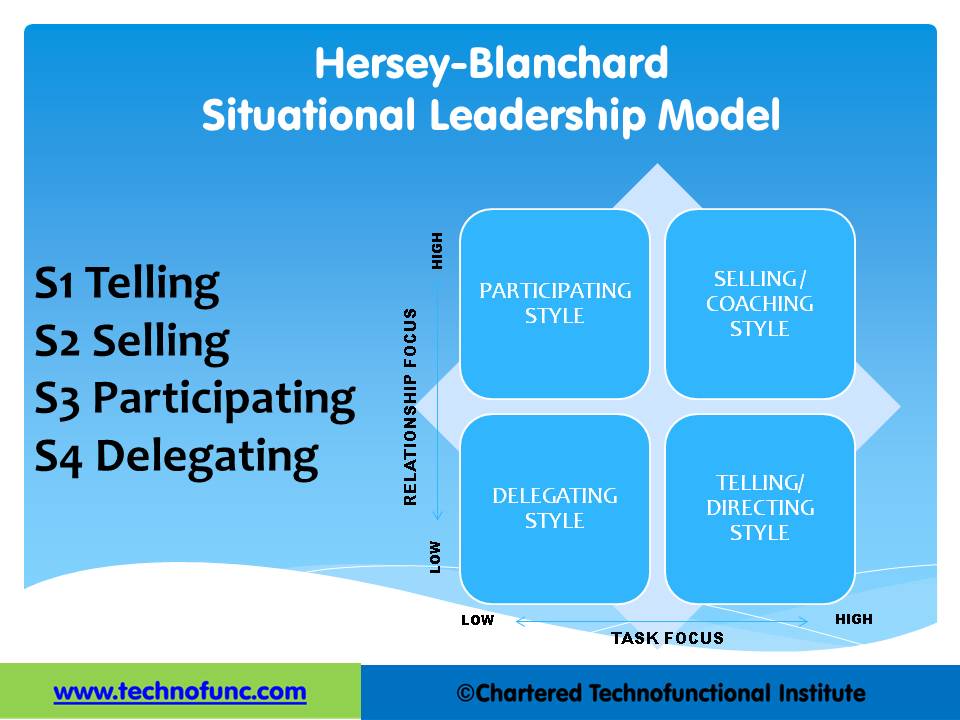- Home
- Business Processes
- Industry Knowledge
- Aerospace Industry
- Automotive Industry
- Banking Domain
- BFSI Industry
- Consumer/ FMCG Industry
- Chemicals Industry
- Engineering & Construction
- Energy Industry
- Education Domain
- Finance Domain
- Hospitality Domain
- Healthcare Industry
- Insurance Domain
- Retail Industry
- Travel and Tourism Domain
- Telecom Industry
- Leadership Skills
- eLearning
- Home
- Leadership
- Leadership Theories
- Situational Leadership - Application
Situational Leadership - Application
Situational Leadership Theories are well known and frequently used for training leaders within organizations. Practical application is how to choose the right leadership approach for the situation. The theory emphasizes leader flexibility and advises leaders to flex their style based on the followers' needs. Leaders must adapt their leadership style to fit the prescribed task, understanding given situation/maturity of followers.
How does this Approach Works?
The situational approach is constructed around the idea that different employees are at different level of development or maturity stages which represents the relative competence and commitment of subordinates for a given task. For leaders to be effective in such situations, it is essential that they determine where subordinates are on the maturity levels and adapt their leadership styles so that their style matches with the style of the development level and the followers can be benefited by the time and energy spent by the leader on it. In a way this approach is mutually beneficial to both follower and the leader as leader can also save his time and energy by understanding the maturity levels of the follower.
It is designed to increase the frequency and quality of conversations about performance and development between managers and the people they work with so that competence is developed, commitment is gained, and talented individuals are retained. Highlighted below are the key learning objectives from this theory:
- Develop an understanding of Interaction Styles and how this model can assist in gaining a greater understanding of yourself and others
- Understand how your preferences can influence you and others
- Understand the importance of adapting own interaction style to increase effectiveness
- Be able to diagnose others’ development levels and choose the appropriate leadership style
- Know why there is no best leadership or coaching style
- Learn to use a common language for coaching and developing others
- Understand the negative impact of over supervision and under supervision on others’ performance and morale
Steps to Apply Situational Leadership Model:
1. Determine the nature of the situation.
2. Understand the nature and complexity of the task at hand
3. Evaluate the skills and the desire of the subordinates to do the task being asked to perform.
4. Identify correctly the specific developmental level at which their subordinates are functioning.
5. Adapt his or her style to the prescribed leadership style represented in the table given in the previous article.
Practical Applications of the Situational Approach:
- This theory is well known and frequently used for training leaders within organizations.
- Perceived by organizations as an effective model for training people to become effective leaders and use the skills in workplace to solve common workplace conflicts.
- Highly practical, easy to understand, sensible theory that can be applied in a variety of settings and situations.
- Provide leaders with a valuable set of guidelines that can facilitate and enhance leadership.
- Emphasizes leader flexibility and recognizes that employees act differently with different tasks and leaders need to flex their style based on the situational or followers need.
- It is an encompassing model with a wide range of applications.

Related Links
You May Also Like
-
Process & Stages of Creativity
Creative ideas do not come just like that. There is a process to it. There are a number of techniques of creativity to support the generation of ideas but the widely practiced ones are brainstorming and lateral thinking. Most innovations are not so much the product of sudden insights as they are the result of a conscious process that often goes through multiple stages. The creative process can be divided into four stages of preparation, incubation, evaluation, and implementation.
-
The Hersey and Blanchard Situational Theory model suggests that a leader must adapt his leadership style based on task and relationship behaviors appropriate to the situation. Leadership style is dependent on the maturity level and abilities of followers. Under this model, successful leadership is both task-relevant and relationship-relevant.
-
Leadership Participation Inventory (LPI)
Kouzes and Posner introduced the Leadership Participation Inventory model of Transformational leadership. This model is also known as Kouzes and Posner's Leadership Challenge Model. They identified five practices of exemplary leadership - Model the Way, Inspire a Shared Vision, Challenge the Process, Enabling Others to Act, and Encourage the Heart.
-
Bass's Transformational Leadership Theory
Bass Transformational Leadership Theory is based on performance beyond expectations approach which defines four elements of transformational leadership. The 4 elements described by Bernard A. Bass in 1985 are Idealised Influence, Intellectual Stimulation, Individualised Consideration, and Inspirational Motivation. This study highlights four key insights about performance beyond expectations and associated criteria to measure it.
-
Self-Fulfilling Prophecy (SFP) Leader Theory
Pygmalion theory of Leadership is a model of SFP at work involving supervisory expectancy based on the pygmalion effect. This effect is a type of self-fulfilling prophecy (SFP) in which raising leader's expectations regarding subordinate performance boosts the group's performance. Managers who are led to demand more from their team, lead the team to better performance. There is some evidence that the SFP effect does exists.
-
Power is the ability to exercise influence or control over others. Leadership involves authority and it is very important for leaders to understand what type of power they're using. The 5 Types of Power in Leadership are Coercive power, expert power, legitimate power, referent power, and reward power. Authority is the right to command and extract obedience from others. It comes from the organization and it allows the leader to use power.
-
Jung first introduced his personality theory and explained that all humans have a natural impulse to relate meaningfully to the world through productive work and people through significant relationships. He used four psychological functions - thinking and feeling (rational functions) and sensation and intuition (irrational functions). He also used introversion and extraversion and its impact on appropriate leader behaviors.
-
Action Centered Leadership is a model developed by John Adair and focuses on the three responsibilities of a leader which are achieving the task, managing the team, and managing individuals. All these action elements are mutually dependent and important for any leader.
-
The Systemic Approach to Leadership
The systemic approach to leadership looks at the organization as a whole and focuses on the understanding of the organization as a system. Moving to systems thinking demand managers to view organizations as organic systems. Leaders are also part of this complex system which is constantly undergoing change and evolving. The leaders need to manage the relations and networks within these systems by acting with systemic awareness.
-
Contingency Theories in Action
Contingency theory suggests matching the best leader to a specific situation based on situational factors and the leadership style. The practical application of theory can be done in various ways. The workplace example is to determine the best candidate for a given set of requirements using the LPC score. Applying the model to determine a leader's ability to adapt in the scenario of a new project etc..
Explore Our Free Training Articles or
Sign Up to Start With Our eLearning Courses

About Us
Learning
© 2023 TechnoFunc, All Rights Reserved










